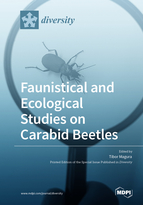Faunistical and Ecological Studies on Carabid Beetles
A special issue of Diversity (ISSN 1424-2818). This special issue belongs to the section "Animal Diversity".
Deadline for manuscript submissions: closed (30 November 2021) | Viewed by 13977
Special Issue Editor
Interests: community ecology; conservation biology; urban ecology; forest ecology; agroecology; biodiversity; ecosystem services
Special Issues, Collections and Topics in MDPI journals
Special Issue Information
Dear Colleagues,
Carabid beetles (Coleoptera: Carabidae) are one of the best-known taxa in entomology. They are common in most terrestrial habitats and geographical areas and can easily be collected using standard methods. Taxonomy, phylogeny, geographic distribution, habitat associations, and ecological requirements of carabid species are well known. Based on the above, carabids are often used as model organisms in faunistical and ecological studies. For this Special Issue I invite the submission of high-quality original research papers and reviews covering all aspects of carabid faunistic and ecology.
Prof. Tibor Magura
Guest Editor
Manuscript Submission Information
Manuscripts should be submitted online at www.mdpi.com by registering and logging in to this website. Once you are registered, click here to go to the submission form. Manuscripts can be submitted until the deadline. All submissions that pass pre-check are peer-reviewed. Accepted papers will be published continuously in the journal (as soon as accepted) and will be listed together on the special issue website. Research articles, review articles as well as short communications are invited. For planned papers, a title and short abstract (about 100 words) can be sent to the Editorial Office for announcement on this website.
Submitted manuscripts should not have been published previously, nor be under consideration for publication elsewhere (except conference proceedings papers). All manuscripts are thoroughly refereed through a single-blind peer-review process. A guide for authors and other relevant information for submission of manuscripts is available on the Instructions for Authors page. Diversity is an international peer-reviewed open access monthly journal published by MDPI.
Please visit the Instructions for Authors page before submitting a manuscript. The Article Processing Charge (APC) for publication in this open access journal is 2600 CHF (Swiss Francs). Submitted papers should be well formatted and use good English. Authors may use MDPI's English editing service prior to publication or during author revisions.
Keywords
- Taxonmy
- Faunistic
- Biogeography
- Ecology
- Biodiversity
- Community
- Axonomic diversity
- Genetic diversity
- Functional diversity
- Phylogenetic diversity
- Ecosystem services
- Ecological process






